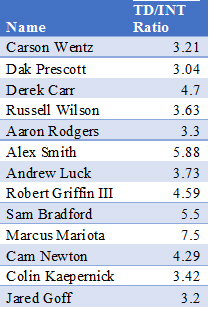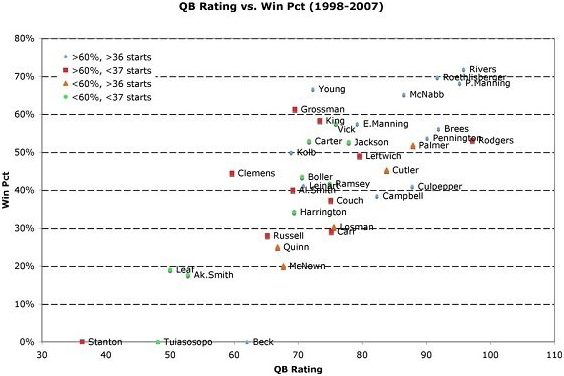AugustUpdate Camp News |
Staff Rankings
| Config Cheat Sheet
| STOMP
Draft Strategies | Depth Charts | Mock Drafts | SOS | Tools | ADP
Diehards Staff Experts Poll | Draft Simulator | University Videos
Draft Strategies | Depth Charts | Mock Drafts | SOS | Tools | ADP
Diehards Staff Experts Poll | Draft Simulator | University Videos
What The Numbers Say About Success And Failure For Quarterbacks Pt 1 The Model
By Adam Hall

It’s QB or bust in the NFL
Few positions in all of sports have the same impact as the quarterback. Due to their preeminence, the goal of finding a model that can predict quarterback success and failure lies at the heart of all scouting departments. No model is perfect however, over the years, I have developed a model that predicts success and failure to a substantial degree. There is no trick; the answer is in college production, along with physical and mental capabilities. This first article will give you a cursory look at the variables that make up the model and why they’re crucial in the complete picture of a franchise quarterback, or a looming bust.Crucial Characteristics
This success and failure model currently has ten variables that are depicted in a step-wise spectrum. The variables are as follows:

Not every one of these variables is as important as the other, but they each help paint a picture of success and failure.
The most important characteristics in the transition from college to the NFL are: career completion percentage, last year completion percentage, and last year yards per attempt (Y/A). If these variables fall under a certain threshold (58.5 for last year completion percentage, and 7.4 for last year Y/A), there are nearly no examples of a player succeeding in the modern NFL.
Each of the ten variables function differently in the model, but they largely separate into three groupings: death knell stats, success characteristics, and correlational trends.
Death Knell Statistics
As mentioned above, there are a few standards of performance or physical characteristics that spell disaster if they are not met. Since 2002, there have been zero quarterbacks who have been successful (average QBR of at least 64 or have been conventionally seen as a top-half quarterback) when they completed fewer than 58.5% of their passes in their final year of college. Furthermore, a last year completion percentage under 60% is nearly always associated with failure in the transition from college to the NFL. A more recent essential criterion has been yards per attempt. In the last decade no quarterback has been successful with a last year yards per attempt under 7.4. The last quarterback to be successful performing under that standard was a statistical aberration in multiple ways: Matt Ryan completed 59.3% of his passes his final year in college and had a Y/A of 6.89. When we look closer both marks were significantly better in his previous years, Ryan also achieved one of the two success metrics.The numbers also produce a pessimistic narrative about players who have hand sizes smaller than nine inches. Only two players since the year 2000 have been successful with having hands under the nine-inch bench mark, (Michael Vick and Tony Romo) and those players were drafted in the early 2000s. The transition to a heavy passing game may require larger hands for better grip and ball positioning. Furthermore, my studies have shown that players with small hands do better in areas with less inclement weather (Jared Goff—Los Angeles, Ryan Tannehill—Miami, Colin Kaepernick—San Francisco, Tony Romo—Dallas, Michael Vick—Atlanta, eventually Philly). With snow, heavy rain, strong winds, and other climate perturbations, it would be difficult to manipulate and control a ball with smaller hands.
Another important characteristic is ball velocity: if a player legitimately has an arm that can only produce a maximum ball speed of 50 MPH, there are very few examples of success at the next level. Players like Mike Glennon have much of what it takes to succeed in the NFL, but just don’t have the requisite arm to beat the athletic freaks on the defense. The hallmark of most pro-style offenses is the play-action pass: when the ball travels more than 20 yards down the field, ball velocity becomes a crucial component of success, and without top-end speed, corners will easily pick off even well-placed balls. The same goes for intermediate or cross field passes: the more ground a QB has to make up with his arm, the more ball speed plays a role. The job of a QB is to get the ball where it needs to be when it needs to be there, and without a sufficiently strong arm, the quarterback is doomed to fail in the NFL.
Both Lamar Jackson and Deshaun Watson threw 50MPH at the combine, but upon further research, these measurements were found to be fallacious. In his article, “Does Deshaun Watson really have a noodle arm?” Tripstep measured Deshaun Watson’s top-end ball speed instead of the 49MPH fastball he threw at the combine, and he found that it was closer to 53.5MPH I followed a similar protocol for Lamar Jackson and found that Jackson’s high end ball speed on average is closer to 55 MPH.
Beyond these three characteristics, everything exists as a piece of evidence instead of as a hard and fast rule.
Success Characteristics
3:1 TD/INT RatioOne huge signifier of future success is a 3:1 touchdown to interception ratio in college. It’s a great sign if this radically increases in the final year; but time and time again, successful quarterbacks throw three or more touchdowns per every interception in college. This shows that the quarterback has an arm that’s sufficient enough to fit throws into coverage that would get other QBs picked off. It is also a statistical explanation of their decision-making capacity: QBs who get by on athleticism often make bad decisions that will only punish them so much on the college level. Though when everyone is an amazing athlete in the NFL, those poor decisions begin to cripple flashy but unsound field generals.
Here’s a list of just a few QBs with a TD/INT ratio of 3:1 or above:

Other players with at least a 3:1 TD to INT ratio:
Mitch Trubiski, Patrick Mahomes, Baker Mayfield, Mason Rudolph, Teddy Bridgewater, Bryce Petty, Tim Tebow, Nathan Peterman, Geno Smith, A.J. McCarron, Brett Hundley, Connor Cook
As you can see, not every quarterback is a success if they meet this benchmark, yet it is highly related to success. This is the first characteristic I look to once the rest of the thresholds for success are met.
Games Started and Won Combination
Another prime characteristic that forecasts success in the NFL is a combination of a high number of games started and won. If a QB starts more than 32 games and wins more than 70% of them, he frequently succeeds in the NFL. John Paulsen at Scoresreport tracked this trend back in 2010, and the stats have maintained their consistency since then---you can see his correlation below.

Failure after achieving this standard keeps you in sparse company---only Tim Tebow, Brett Hundley, Pat White, and EJ Manual fit that bill since 2000.
It’s important to remember: just because a quarterback failed to achieve these heights doesn’t mean that he is doomed on the next level. Tom Brady only registered a 1.8 TD/INT ratio, while Aaron Rodgers and Cam Newton only started 22 and 14 games, respectively. These are indicators of success, not strikes against QBs.
Correlational trends
The rest of these trends fit into what I call correlational trends. I’ve found that when QBs have these characteristics in spades, they often do well, though the same can be said for when they fail to measure up.
Every characteristic listed is a trend variable, but a holistic take is necessary to complete an evaluation of a quarterback. Winning only 37.8 percent of his games didn’t relegate Jared Goff to the trash heap of the league; meanwhile, Tom Brady’s 1.8 TD to INT ratio didn’t stop him from becoming the greatest quarterback to ever play the game.
When looking through the numbers, the more top-end characteristics a player exhibits, the more confident an evaluator should be about his prospects of becoming an elite quarterback.
The choice is clear between two first-round picks and a fourth-round pick in this case:

The successful QBs check the boxes that you want to see and are great where they need to be. The rest is plain to see: Jake Locker’s career was nothing more than a fool’s errand, while Andrew Luck was marked for greatness.
Now armed with this understanding, the expectations for quarterbacks old and new come into view.
Now that the model itself has been covered, part 2 will primarily focus on the model’s ability to stably predict when a quarterback is highly unlikely to succeed in the NFL.
